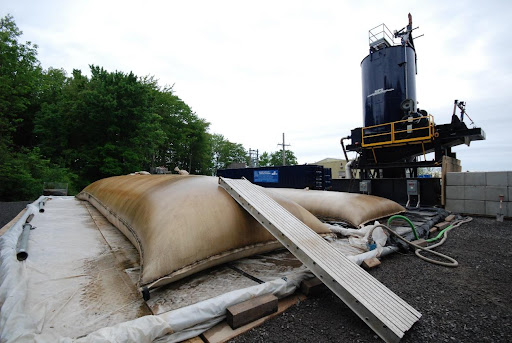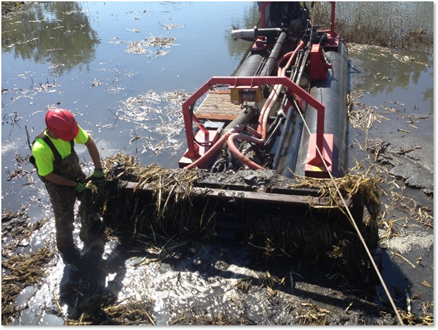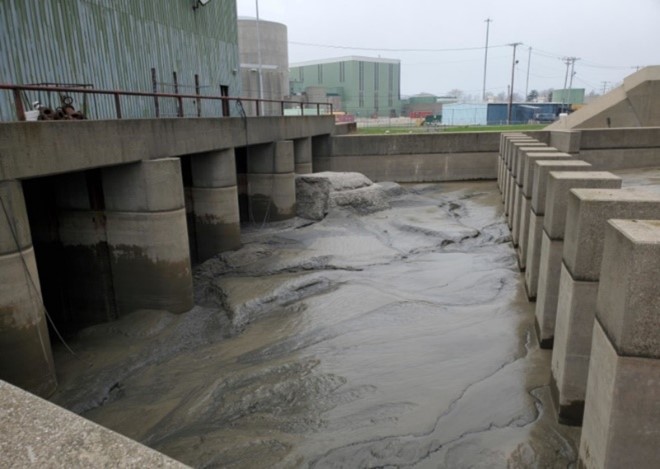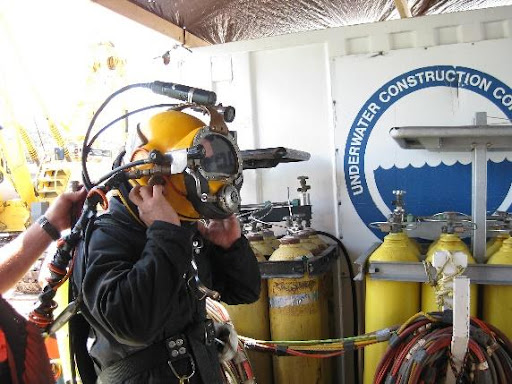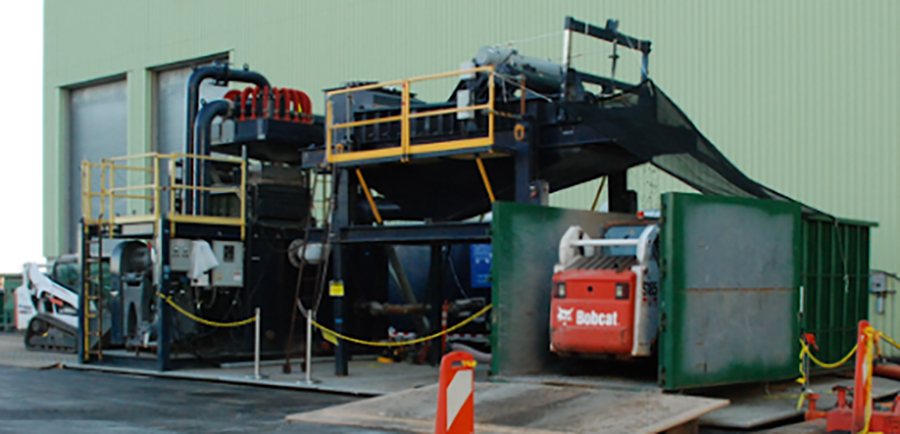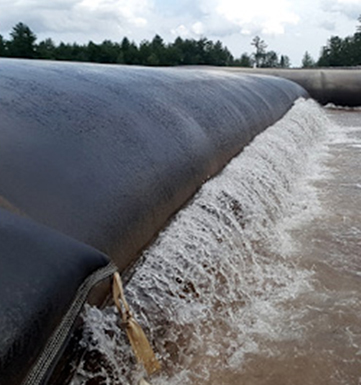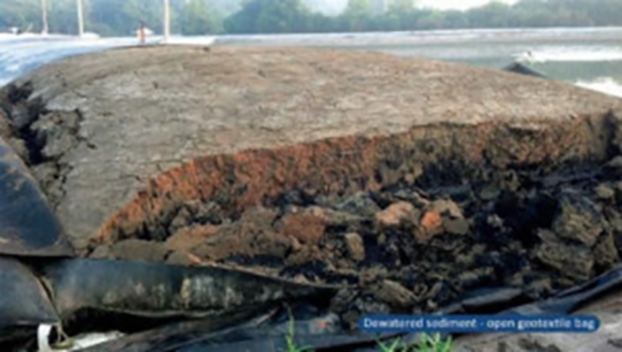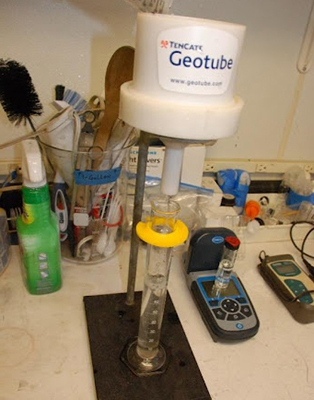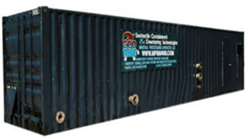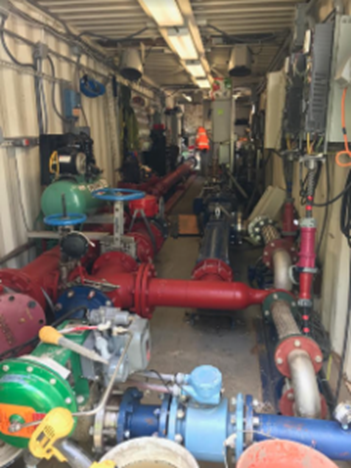Hydraulic Dredging, Sediment & Sludge Processing
2,000 GPM Hydraulically Dredged Sediment Mechanical / Centrifuge Dewatering System: Photo J. Meagher – UMPS
Geotextile dewatering tubes are a proven technology for sediment removal and processing. UMPS perfects that technology with several supporting technologies, such as Geotube® textile dewatering structures and the Smartfeed® chemical conditioning system.
These technologies support hydraulic dredging operations in pits, ponds, and lagoons, as well as diver hand-vacuum sediment removal and processing around water intake structures.
This approach results in faster and more efficient dredged sediment dewatering. Often, the discharge water returns directly to the water source. Geotube® textile dewatering structures that can deliver the best sediment dewatering performance based on testing samples, and the Smartfeed® chemical conditioning system ensure proper dosing of dredged and diver-removed slurries. Learn more about our dewatering and containment solutions for industrial environments.
Hydraulic Dredging – Pits, Ponds and Lagoons
Whether the target for sediment removal is a pit, pond, or lagoon, these sources will require periodic dredging of accumulated solids. This removal task can be done mechanically, often by using an excavator, clam-shell crane, mechanical dredge filling hopper barges transported to upland processing and disposal operations.
Mechanical dredging/excavation is an exceptionally inefficient means of dewatering solids from pits, ponds or lagoons due to overlapping or missing dredged areas.
In addition, mechanical dredging requires frequent repositioning of the equipment over un-dredged areas, and creates high turbidity plume conditions due to entrainment of sediments into the water column from the excavation bucket dredging.
The use of hydraulic auger head dredging units, such as the UMPS Pit-Hog robotic hydraulic dredge shown in the photo, are far more efficient as they are operated on a cable/rail land-based mooring system. This permits the hydraulic dredge operator precise control in indexing the next horizontal cut along with carefully controlling the depth of the cut – sometimes referred to as “mowing the lawn”. This combination optimizes the recovery rate of the dredged sediments with minimizing the entrainment of fines and turbidity plumes within the dredge area.
In certain cases, the materials being dredged from the lagoon, pit or pond may be contaminated and present environmental hazards that cannot be allowed to escape a containment area. Hydraulic dredging conducted by experienced robotic dredge operators and commercial divers represents the safest and most efficient means of capturing contaminated or dangerous materials for dewatering. Hydraulic dredging operations focus specifically on the areas excavated, and silt curtains can be placed to control turbidity and effluent more precisely than can be achieved through mechanical excavation.
Water Intake Hydraulic Dredging & Sediment Removal/Processing
Power plants, certain factories and industrial operations, along with regional drinking water treatment plants, rely on proper water flow for hydroelectric power generation, process cooling and municipal water supplies. Maintenance of water intakes removing sediment, debris, obstructions and damage are critical to safe, reliable operation.
Keeping water intakes operating efficiently requires the periodic inspection, removal and processing of sediments from the intake area.
Typically, in confined underwater conditions such as around water intake structures where a hydraulic auger-head dredge cannot operate, UCC deploys commercial divers using handheld hydraulic vacuum dredges to remove accumulated sediment material to ensure the entire subject area of the water intake structure, screens, valves and race ways are completely cleaned of sediment and debris.
UCC commercial divers using hand-held hydraulic dredging removes sediment from around the angles, eddies and structures that abut water intakes, versus mechanical dredging without structural damage that a mechanical dredge can cause.
Removed sediment and sludge materials by either UMPS Pit-Hog robotic hydraulic dredging or UCC precision diver vacuum dredging is directed to the UMPS’ turnkey slurry processing system modules. These turn-key systems include debris scalping, vibratory screen dewatering of coarse/medium sand fractions, and hydrocyclone separation and high frequency vibratory screen dewatering of fine sand cuts.
The UMPS Smartfeed® computer-controlled polymer chemical addition, provides crucial flocculation conditioning of the fine silt, clay and colloidal fractions of the slurry. Once flocculation of the fine fractions commences, the thickened slurry is directed to a UMPS High-rate Clarifier/Paste Thickener which produces an ideal feed to decanting centrifuges, plate and frame filter presses or Geotube® geotextile dewatering structures. UMPS Smartfeed® computer-controlled polymer chemical addition units can process up to 4,000 gallons/minute of hydraulic dredge slurry feed.
Additionally, where a client’s work area does not permit significant space for processing or decanting of the dredged sediments, mechanical separation, geotextile tube dewatering, coupled with chemical conditioning, can drastically reduce the area required for water intake sediment processing.
Geotextile Tube Dewatering
Geotextile dewatering structures tubes solve these challenges by reducing the required laydown area and maximizing the decant rate of dredged materials, especially when coupled with a proper chemical conditioning program.
UCC and its subsidiary, Underwater Mineral Processing Services (UMPS), use Geotube® textile dewatering structures for improving water/solids separation performance and reducing laydown area requirements.
Manufactured by TenCate®, a global leader in engineered textiles, Geotube® geotextiles have consistently exhibited the reliability and efficiency to improve dewatering projects. Coupled with a chemical conditioning program administered by the Smartfeed® system, dewatering time and efficiency are often several times improved over natural decantation and drying times.
Because Geotube® geotextile tube dewatering is efficient, it reduces the complexity and cost of dried sediments removal to an offsite location. When sufficient area is available, following the completion of the slack-drying period, the Geotube® structure and its contents can often be disposed of, in-place, as a unit. Where the geotextile tube contents cannot stay on site, the Geotube® geotextile tube can be cut open, the dewatered sediment excavated and transported to an approved disposal site, and the used geotextile tube material removed to an alternate disposal site.
Additionally, because the dewatering properties of Geotube® geotextile tubes are superior to natural air drying and decanting, the dredged and dewatered solids are drier, reducing the weight of the disposed materials and often reducing tipping fees.
Each Geotube® geotextile tube material and weave are matched with the customer’s project requirements, based on representative sample testing of the slurry processed. The UMPS filtration laboratory testing ensures maximum performance of the geotextile tube and reliable outcomes from every dewatering project.
UMPS has experience placing Geotube® geotextile tubes in constricted work areas. UMPS has success deploying geotextile tubes on and within barges, minimizing required land-based work area. Geotextile tubes can be stacked, manipulated to fit available laydown areas, distributed across multiple site locations, and removed more efficiently than uncontained solids during and at the conclusion of a dredging project.
Explore the benefits of Geotextile tube dewatering technology and reach out to our experts to discuss how partnering with UMPS can benefit your project.
Geotube® Smartfeed® Sediment and Sludge Dewatering
Geotextile tubes accelerate the dewatering of dredged sediments and materials. They simplify disposal and often reduce disposal costs.
When coupled with a properly managed chemical conditioning program, geotextile tube dewatering becomes exceptionally efficient, in a measurable, repeatable and reportable program.
UMPS developed the Smartfeed® chemical conditioning system to support Geotube® geotextile tube dewatering projects.
The Smartfeed® chemical conditioning system features:
- Filtration laboratory testing parameters assuring the most efficient chemical conditioning program is maintained in full-scale applications.
- Self-contained, fully portable solution delivered to the worksite in a standard utility trailer or roll off container, depending on project requirements.
- Constant monitoring of the sludge or sediment slurry properly dosed, with automatic adjustment of the chemical conditioning. This ensures both maximum performance and ensures efficient dosing, eliminating waste.
- Exportable reporting that details the results of each phase of the sediment and sludge dewatering project. Key performance indicators are constantly captured and readily output to Microsoft Excel, ensuring stakeholders are fully informed about project performance.
The Smartfeed® chemical conditioning system is chosen by organizations that must have efficient, measurable and reliable performance of sediment and sludge dewatering. When project timelines are tight, accountability is mandatory and the margin for error is narrow, many clients have called upon UMPS to provide integrated dredge services, Smartfeed® chemical conditioning, coupled with Geotube® geotextile tube dewatering structures for a successful turn-key solution. Learn how to optimize your slurry and sludge management process with Smartfeed®.
Recent UCC and UMPS Projects
Contact Our Hydraulic Dredging, Sediment & Sludge Processing Experts
If you have a potential hydraulic dredging or dewatering project, we want to hear from you. Our team can assess your specific needs and recommend the most effective approach to help ensure you meet your goals. To get started, spec your project or contact us. We will be in touch shortly. You can also contact Jim Meager directly at 207-741-2955 or [email protected] for any of your hydraulic dredging, sediment and sludge processing needs.
